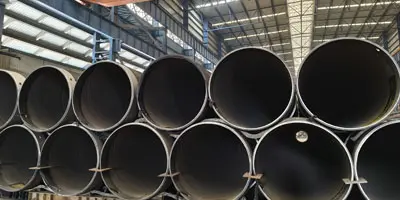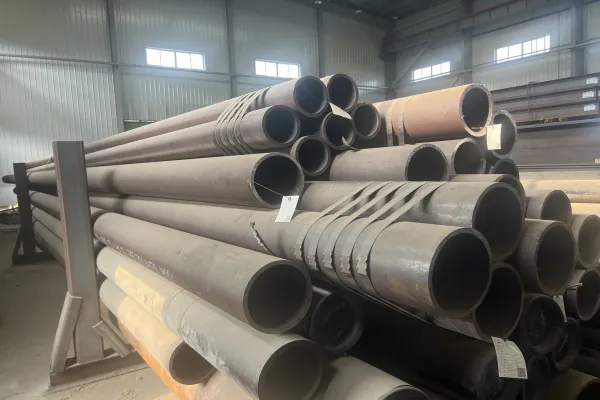Due to the continuous development of urbanization construction, materials in the building materials market have emerged one after another. Although these materials are relatively common in our daily life, people who do not usually run in the building materials market may not know carbon steel. material, we will not understand its advantages and disadvantages, and even we will ignore its existence. Next, today I will explain to you what kind of material carbon steel is? And what are its advantages and disadvantages?
What is Carbon Steel Pipe?
Carbon steel pipe is made primarily of iron and carbon, with small amounts of other elements such as manganese, silicon, and sulfur. It is classified into seamless and welded carbon steel pipes, with each type serving different applications. The high strength and durability of carbon steel make it a preferred material in industries requiring structural integrity and long service life.Carbon steel mainly refers to steel whose mechanical properties depend on the carbon content in the steel. Generally, a large amount of alloying elements are not added. It is sometimes called ordinary carbon steel or carbon steel. Carbon steel, also known as carbon steel, refers to an iron-carbon alloy with a carbon content of less than 2% WC. In addition to carbon, carbon steel generally contains a small amount of silicon, manganese, sulfur, phosphorus, etc. Generally, the higher the carbon content of carbon steel, the greater the hardness and strength, but the lower the plasticity.
Types of Carbon Steel Pipe
1.
Seamless Carbon Steel Pipe – Manufactured without a welded seam, making it stronger and suitable for high-pressure applications.
2.ERW (Electric Resistance Welded) Carbon Steel Pipe – Made by welding steel sheets or coils, offering a cost-effective solution for fluid transportation.
3.LSAW (Longitudinal Submerged Arc Welded) Carbon Steel Pipe – Used for large-diameter pipelines, commonly found in oil and gas transmission.
4.SSAW (Spiral Submerged Arc Welded) Carbon Steel Pipe – Ideal for large-diameter and long-distance pipelines, especially in water and gas transportation.
Advantages of Carbon Steel Pipe
1. High Strength and Durability
Carbon steel pipes are known for their exceptional strength, making them ideal for high-pressure and heavy-duty applications. Compared to other materials, such as PVC or aluminum, carbon steel offers superior mechanical properties.
2. Cost-Effective Solution
Carbon steel is relatively inexpensive compared to stainless steel or copper pipes. This makes it a budget-friendly option for industrial applications where large quantities of pipe are needed.
3. Excellent Heat and Pressure Resistance
Carbon steel pipes can withstand extreme temperatures and high pressures, making them suitable for steam, oil, and gas transmission. Industries such as power plants, chemical processing, and refineries benefit from this characteristic.
4. Wide Range of Applications
Oil and Gas Industry – Used in pipelines for crude oil, natural gas, and petroleum products.
Construction and Infrastructure – Utilized in bridges, buildings, and structural frameworks.
Water and Wastewater Treatment – Commonly found in municipal water supply systems.
HVAC and Fire Protection Systems – Carbon steel is often used in fire sprinkler systems and HVAC ductwork.
5. Recyclability and Sustainability
Carbon steel pipes are 100% recyclable, making them an environmentally friendly option. The steel industry has improved production methods to reduce carbon emissions, contributing to sustainability efforts.
6. High Impact Resistance
Carbon steel pipes can withstand mechanical impact and rough handling, which is crucial for transportation and construction projects.
7. Compatibility with Coatings and Linings
To improve corrosion resistance, carbon steel pipes can be coated with materials such as epoxy, polyethylene, or galvanized zinc, extending their lifespan in harsh environments.
Disadvantages of Carbon Steel Pipe
1. The hot hardness of carbon steel will be poor, because when the working temperature of the tool is greater than 200 degrees, its hardness and wear resistance will drop sharply.
2. The hardenability of carbon steel is very low. The diameter of the fully hardened steel is generally about 15-18 mm during water quenching, while the diameter or thickness of the carbon steel is only about 6 mm when it is not quenched, so it will be easier to deform and crack.
3. Limited Resistance to Chemicals
While carbon steel is strong, it is not highly resistant to acidic or alkaline substances. In industries dealing with aggressive chemicals, stainless steel or lined pipes may be a better option.
4. Requires Regular Maintenance
To prevent rust and degradation, carbon steel pipes need periodic inspection, cleaning, and protective treatments, adding to long-term operational costs.
5. Susceptibility to Brittle Fracture in Low Temperatures
In extremely cold conditions, carbon steel can become brittle and more prone to cracking, making it less ideal for cryogenic applications.
Basic process of carbon steel pipe
The so-called carbon steel pipe actually refers to the mechanical properties that depend on the carbon content in the steel pipe. Generally, steel pipes that do not add a large amount of alloying elements are also called ordinary carbon steel pipes or carbon steel pipes, which refer to iron-carbon alloy pipes with a carbon content of less than 2%. In addition to carbon, carbon steel pipes also contain a small amount of silicon, manganese, sulfur, phosphorus, etc. Generally, the higher the carbon content in carbon steel pipes, the greater its hardness and strength, but the lower its plasticity.
Carbon Steel Pipe Manufacturers
As a leading carbon steel pipe supplier, BAOWI STEEL provides high-quality steel pipe products and customized solutions to customers around the world with years of professional manufacturing experience. Our products cover carbon steel pipes, stainless steel pipes, hollow profiles, pipe fittings and other fields, and are widely used in oil and gas, building structures, machinery manufacturing, infrastructure, shipbuilding industry and other industries.






 English
English Español
Español بالعربية
بالعربية











 Phone :
Phone :  Whatsapp :
Whatsapp :  Email :
Email : 


